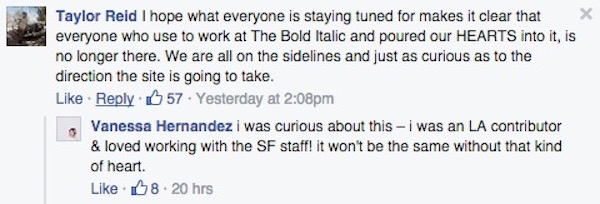
The Bold Italic is coming back. After being shut down abruptly by Gannett in April, the local San Francisco site is returning under new ownership.
Sunil Rajaraman, cofounder of the startup Scripted, and tech writer Sonia Arrison said in a Facebook post that they had formed a new company and bought the site from Gannett. They will maintain the site’s archives and said they plan to begin publishing new content in late July or early August. They’ll be experimenting with different business models to try to find a sustainable way to maintain the site.
“Our objective is to keep consistent with the brand that The Bold Italic built up over the years successfully,” Rajaraman told me.
We love you, San Francisco. It’s been a great run! Thanks for being a supporter on our journey. http://t.co/7tcn8NHEYD
— The Bold Italic (@thebolditalic) April 7, 2015
The Bold Italic lives, stay tuned for more soon.
— The Bold Italic (@thebolditalic) June 22, 2015
Rajaraman wouldn’t disclose the terms of the agreement with Gannett, and he said the site had yet to develop any revenue goals. “The priority is getting the site to a sustainable state over the next year,” he said. Scripted, the freelance writing marketplace he cofounded, has raised $14.5 million since its 2011 launch, according to CrunchBase.
Rajaraman and Arrison were in talks with Gannett for almost two months. Before completing the sale, Rajaraman said the duo consulted with former Bold Italic staffers to gauge their response to the site’s revival.
“All of the former staff members were very courteous — they didn’t provide us with their instant response about how they’d feel if someone took it over, but what I can tell you is all of them were friendly, generous with their time, and all of our meetings with them were extremely cordial,” he said. “My walkaway from a lot of those meetings was, given the choice of the site shutting down and keeping the work alive of the hundreds of people who contributed over the years, they would much rather keep the site alive.”


The staff who worked at the previous iteration of The Bold Italic lost their jobs when the site went under in April, so Rajaraman and Arrison are starting over in terms of building a staff and finding freelancers to write for the site. (The Bold Italic’s site currently lists the old staff, though.) Rajaraman said the new site has yet to hire anyone, but he and Arrison plan on making some additions — including, potentially, rehiring former staff members — in the coming weeks.
“You can expect us over the next few weeks, after we talk to other former staff members and freelancers, to figure out what was working and what was not working,” Rajaraman said.
The Bold Italic was launched by Gannett in 2009, in partnership with the design firm IDEO, as an experiment to build a new type of local news and information site. The site de-emphasized that Gannett ownership, while saying that it wasn’t explicitly a news site. Instead, the site focused its business and editorial operations around community engagement.
“We found that people really wanted to feel really good about living in the city that they’re in and celebrate things and uncover and discover new things to do there, as well as stay informed,” Michael Maness, the former Gannett vice president for innovation and design who oversaw the site’s launch, told me in April when the site was shuttered.
Maness said the site was designed to exist in “a world without advertising,” and as a result The Bold Italic was early among online outlets in focusing on events as a revenue strategy — though it still ran banner and native ads.
Events will continue to play a role in The Bold Italic’s business model, Rajaraman said. He emphasized that the site would experiment with other options as well, though he said they have no plans “anytime soon” to erect a paywall or charge for content.
The site also plans to grow its coverage to larger swaths of the Bay Area, and Rajaraman said he’d ultimately like to expand the site to cover other cities as well. Gannett’s original goal with The Bold Italic was to move into additional markets; that’s why they chose a name that wasn’t specifically tied to San Francisco. In 2014, the site began some coverage of Los Angeles. Still, Rajaraman said they aren’t planning on expanding beyond the Bay Area in the next year or so, though he did mention Los Angeles and Seattle as potential targets for where The Bold Italic could grow.
“There are a couple ways to crack this, hopefully, but one is expanding the audience and the other is experimenting with different revenue models,” he said.